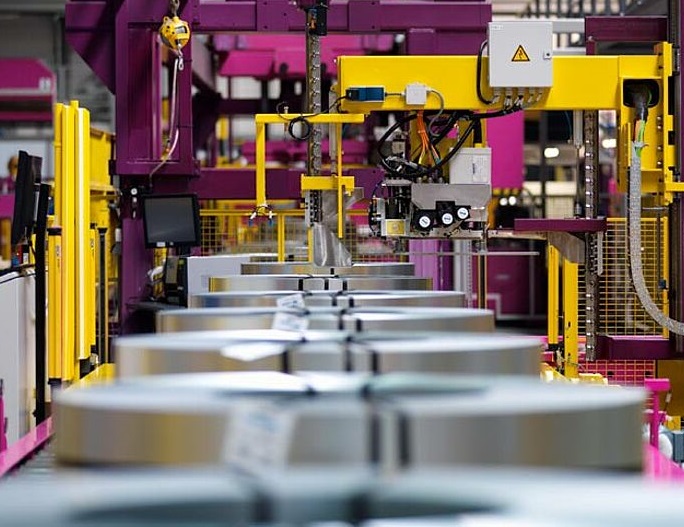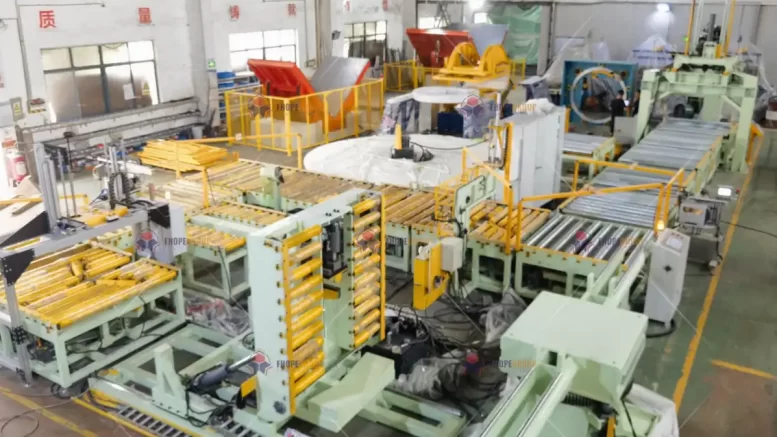In today's fast-paced industrial world, the implementation of an automated steel packing line can be a game-changer for your business. However, the journey from purchase to full operation isn't always smooth sailing. Ensuring a seamless delivery process is crucial to maximize your investment and minimize downtime. In this comprehensive guide, we'll walk you through the essential steps and strategies to make sure your automated steel packing line arrives and integrates into your operations without a hitch.
Understanding the Importance of Seamless Delivery
Before we dive into the nitty-gritty, let's take a moment to appreciate why seamless delivery is so critical. An automated steel packing line is not just a piece of equipment; it's a complex system that will become the backbone of your production process. Any hiccups in delivery can lead to:
- Costly production delays
- Missed customer deadlines
- Unnecessary stress on your team
- Potential damage to expensive equipment
By prioritizing a smooth delivery process, you're setting the stage for long-term success and efficiency in your operations.
1. Thorough Pre-Delivery Planning
The key to seamless delivery starts long before the equipment leaves the manufacturer's facility. Proper planning is your first line of defense against potential issues.
Creating a Detailed Project Timeline
Start by working closely with your supplier to create a comprehensive timeline. This should include:
- Manufacturing completion date
- Expected shipping date
- Estimated arrival time
- Installation schedule
- Testing and commissioning phases
Remember, a well-structured timeline acts as a roadmap for your entire team, keeping everyone aligned and accountable.
Assigning Roles and Responsibilities
Clear communication is crucial. Designate specific roles within your organization:
- Project Manager: Oversees the entire delivery and installation process
- Logistics Coordinator: Handles transportation and customs clearance (if applicable)
- Site Preparation Team: Ensures your facility is ready to receive the equipment
- Technical Liaison: Communicates with the supplier on technical specifications and requirements
By clearly defining who's responsible for what, you'll avoid confusion and ensure nothing falls through the cracks.
2. Site Preparation: Laying the Groundwork
A smooth delivery starts with a well-prepared site. Don't underestimate the importance of this step!
Assessing Spatial Requirements
Your automated steel packing line will need ample space not just for operation, but for installation as well. Consider:
- Equipment footprint
- Clearance for maintenance access
- Space for material flow and storage
- Future expansion possibilities
Pro tip: Use tape or chalk to mark out the equipment layout on your floor. This visual aid can be incredibly helpful for planning.
Infrastructure Readiness
Ensure your facility can support the new equipment:
- Electrical capacity: Verify that your power supply can handle the increased load
- Compressed air: Check if your current system can meet the new demand
- Network connectivity: Prepare any necessary data lines or wireless access points
- Floor strength: Confirm that your floor can support the weight of the equipment
Remember, addressing these issues before delivery can save you from costly delays later on.
3. Transportation Logistics: The Journey Matters
Getting your automated steel packing line from the manufacturer to your doorstep is a critical phase. Here's how to ensure it goes smoothly:
Choosing the Right Shipping Method
Depending on the origin of your equipment and your location, you might be dealing with:
- Overland trucking
- Sea freight
- Air cargo (for smaller components)
Each method has its pros and cons in terms of cost, speed, and handling. Work with experienced logistics providers who understand the unique challenges of transporting heavy industrial equipment.
Customs Clearance (for International Shipments)
If you're importing your equipment, customs clearance can be a potential bottleneck. To streamline this process:
- Prepare all necessary documentation well in advance
- Consider hiring a customs broker familiar with industrial machinery imports
- Stay in close communication with your supplier for any required certificates or declarations
Proactive management of customs procedures can save you days or even weeks of delay.
4. Receiving and Inspection: The Crucial First Look
The moment your automated steel packing line arrives at your facility is exciting, but it's also a critical juncture for ensuring everything is in order.
Coordinating the Unloading Process
Have a plan in place for safely unloading the equipment:
- Ensure you have the necessary forklifts or cranes available
- Clear a path from the delivery vehicle to the installation site
- Brief your team on safety procedures for handling large machinery
Conducting a Thorough Inspection
Before signing off on the delivery:
- Check for any visible damage to crates or packaging
- Verify that all expected components are present
- Document any discrepancies or concerns immediately
Taking the time for a careful inspection can save you from headaches down the line. If you spot any issues, communicate them to your supplier promptly.
5. Installation Preparation: Setting the Stage
With your equipment on-site and inspected, it's time to prepare for the installation phase. This is where your earlier planning really pays off.
Assembling Your Installation Team
Whether you're using in-house technicians or the supplier's team, ensure everyone is briefed and ready:
- Review the installation plan and timeline
- Confirm all necessary tools and equipment are on hand
- Assign specific tasks and areas of responsibility
Creating a Safe Work Environment
Safety should always be your top priority:
- Establish clear safety protocols for the installation process
- Provide necessary personal protective equipment (PPE)
- Ensure all team members are trained on relevant safety procedures
6. The Installation Process: Bringing Your Vision to Life
Now that the groundwork is laid, it's time to bring your automated steel packing line to life. This phase is where precision and attention to detail are paramount.
Following the Installation Sequence
Most automated steel packing lines consist of multiple components that need to be installed in a specific order. Typically, this sequence includes:
- Foundation and flooring preparation: Ensuring a level and stable base
- Main frame assembly: Setting up the core structure of the line
- Conveyor system installation: Laying out the material handling path
- Wrapping and strapping units: Positioning the key packaging components
- Control systems and wiring: Connecting the brains of the operation
- Auxiliary equipment: Adding any additional features or customizations
Adhering to this sequence helps prevent conflicts and rework later in the process.
Precision Alignment and Calibration
The efficiency of your automated steel packing line hinges on precise alignment. Pay special attention to:
- Leveling each component using laser levels and precision tools
- Aligning conveyor sections for smooth material transfer
- Calibrating sensors and control systems for accurate operation
Remember, even small misalignments can lead to significant issues down the line. Take the time to get this right.
7. Testing and Commissioning: Proving the Concept
With installation complete, it's time to bring your new line to life and ensure it meets all specifications.
Conducting Systematic Tests
Start with individual component testing before moving to full system integration:
- Power-up tests: Ensure all electrical systems are functioning correctly
- Mechanical function tests: Verify that all moving parts operate as intended
- Control system checks: Confirm that the PLC and HMI are communicating properly
- Material handling trials: Test with sample products to ensure smooth flow

Document all test results meticulously. This information will be invaluable for future reference and troubleshooting.
Fine-tuning for Optimal Performance
As you run your tests, you'll likely identify areas for improvement. Common adjustments include:
- Tweaking conveyor speeds for optimal product flow
- Adjusting wrapping tension for different product sizes
- Fine-tuning strapping positions for secure packaging
- Optimizing control system parameters for efficiency
Don't rush this process. Taking the time to dial in your system now will pay dividends in long-term performance and reliability.
8. Operator Training: Empowering Your Team
A seamless delivery isn't complete without ensuring your team is fully prepared to operate the new equipment.
Developing a Comprehensive Training Program
Work with your supplier to create a training program that covers:
- Basic operation and control interface usage
- Routine maintenance procedures
- Troubleshooting common issues
- Safety protocols and emergency procedures
Consider creating a mix of classroom-style learning and hands-on practice sessions for optimal retention.
Creating Detailed Documentation
Supplement your training with clear, accessible documentation:
- Step-by-step operating manuals
- Quick-reference guides for common tasks
- Maintenance checklists and schedules
- Troubleshooting flowcharts
Having these resources readily available will empower your team to handle day-to-day operations confidently.
9. Handover and Initial Production Run
The moment of truth arrives as you prepare to take full ownership of your automated steel packing line.
Conducting a Formal Handover
Arrange a formal handover session with your supplier, covering:
- Final inspection of all components
- Review of all documentation and certifications
- Clarification of warranty terms and support procedures
- Sign-off on project completion
This formal process ensures all parties are aligned on the state of the delivery and installation.
Planning Your First Production Run
Approach your initial production run with caution and attention to detail:
- Start with a small batch to minimize risk
- Have experienced operators and technicians on hand
- Monitor all aspects of the process closely
- Document any issues or observations for future optimization
Consider this first run as an extended part of your testing phase, with the goal of identifying any final adjustments needed.
10. Post-Installation Support and Maintenance
Ensuring long-term success goes beyond the initial installation and setup.
Establishing a Maintenance Schedule
Work with your supplier to create a comprehensive maintenance plan:
- Daily checks and cleaning procedures
- Weekly or monthly preventive maintenance tasks
- Scheduled component replacements or upgrades
Adhering to this schedule will help prevent unexpected downtime and extend the life of your equipment.
Ongoing Training and Support
Consider implementing:
- Regular refresher training sessions for your team
- A system for sharing best practices and lessons learned
- A clear process for escalating issues to your supplier's support team
Continuous learning and improvement will help you maximize the value of your investment over time.
11. Data Collection and Performance Optimization
In today's data-driven world, leveraging the information from your automated steel packing line can provide significant advantages.
Implementing Performance Monitoring
Set up systems to track key performance indicators (KPIs) such as:
- Throughput rates
- Packaging material usage
- Downtime incidents and causes
- Quality metrics (e.g., package integrity, labeling accuracy)
Regular analysis of these metrics can help you identify trends and opportunities for improvement.
Continuous Improvement Initiatives
Use the data you collect to drive ongoing optimization:
- Regular team meetings to review performance and brainstorm improvements
- A/B testing of different settings or procedures
- Collaboration with your supplier on potential upgrades or enhancements
Remember, the delivery and installation of your automated steel packing line is just the beginning of your journey towards operational excellence.
Conclusion: The Key to Long-Term Success
Ensuring a seamless delivery for your automated steel packing line is a complex but rewarding process. By focusing on thorough planning, precise execution, comprehensive training, and ongoing support, you set the stage for long-term success and efficiency in your operations.
Remember that the process doesn't end with the initial installation. Continuous monitoring, maintenance, and optimization are crucial to maximizing the value of your investment over time. Embrace the journey of continuous improvement, and you'll find that your automated steel packing line becomes not just a piece of equipment, but a cornerstone of your competitive advantage in the market.
By following the strategies outlined in this guide, you're well on your way to a smooth integration that will boost your productivity, enhance product quality, and drive your business forward. Here's to your success in automated steel packing – may your line run smoothly for years to come!
